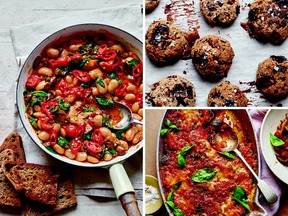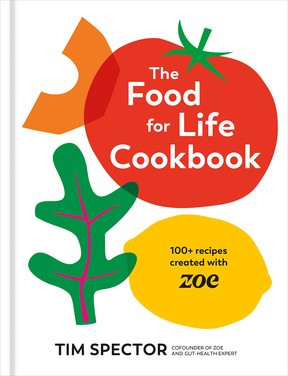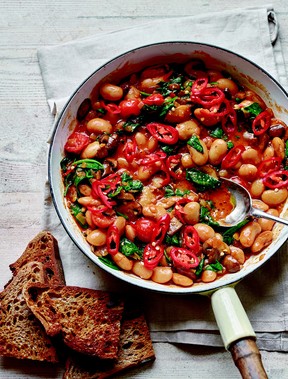Cook This: 3 gut-friendly recipes from The Food for Life Cookbook, including spicy gochujang beans
Microbiome expert and author Tim Spector shares more than 100 recipes for better gut health

Article content
Our cookbook of the week is The Food for Life Cookbook by Tim Spector, a U.K.-based medical doctor, professor, author, microbiome expert and co-founder of the nutrition science company ZOE.
Jump to the recipes: spicy gochujang beans, eggplant parmigiana and pecan chocolate cookies.
The most popular video microbiome expert Tim Spector has ever posted isn’t about cutting-edge gut-health science. It’s what he eats for breakfast.
“People want real, practical tips,” says Spector, an epidemiology professor at King’s College London, bestselling author, medical doctor and co-founder of the U.K.-based nutrition science company ZOE. The video of his go-to “breakfast” bowl, a mix of yogurt, kefir, berries, nuts and seeds, has roughly four million views.
“It’s the simplest of things, but I think it summed up, ‘Yeah, OK.’ There are bits in there that, all put together, you can start to see some of the principles about healthy eating, which I think people otherwise struggle to see, unless they can see a real, practical reality of what it means every day in your real life.”
In his 2022 book, Food for Life, Spector shared science-backed advice on how to eat well. It took him six years to complete and was more successful than he expected, given its scientific bent — “lots of pages and lots of facts.” At talks, audience members invariably asked for meals encompassing the book’s principles. That, coupled with the number of people interested in what he eats for breakfast and the popularity of some of the recipes on the ZOE app, made him realize that there was an appetite for a companion cookbook.
The Food for Life Cookbook features more than 100 recipes created with recipe developers and ZOE nutritionists. It opens with Spector’s journey connecting the dots between science, cooking and how food choices affect our health. In 2011, he had a mini-stroke on a backcountry skiing trip. “My long recovery left me with high blood pressure that I couldn’t ignore, giving me the wake-up call I seriously needed.”
As a clinician, Spector thought he knew what a healthy diet was. It gradually dawned on him during his recovery that there was so much more to it. “Nutrition changed from being this really dull science of nutritional deficiencies, vitamins, calories, malnutrition, just getting enough of the basics, to this expanding, super-exciting science about chemicals and metabolites and microbes and all kinds of effects on the whole of your body.”
The Food for Life Cookbook features a condensed version of the six principles for gut health outlined in its theoretical counterpart: eat 30 plants a week; eat the rainbow; pivot your protein; think quality, not calories; incorporate fermented foods; and try time-restricted eating.

The first principle alone changed how I approach my meals. Rather than focusing on the number of servings of fruit and vegetables a day, Spector encourages broadening the scope. Eating 30 different plants a week may seem daunting, but herbs and spices, nuts and seeds, grains and legumes, coffee and dark chocolate all count.
In practice, this meant that instead of stopping with toasted nuts and berries to top my oatmeal, I added seeds, such as hemp and pumpkin, and shredded coconut. I cut the oats with barley flakes and stirred in grated nutmeg. For a savoury bowl, I added three types of seaweed and dukkah or chili crisp. These embellishments may seem minor, but they add up when it comes to the health of the gut microbiome. They also make meals more delicious.
“I think it’s quite novel as a concept of looking for every meal to see, ‘What can I add to it?’ rather than, ‘What’s the bare minimum I can do for it to be tasty?'” says Spector.
Through his work on the American/British Gut Project, Spector discovered that the diversity of plant species we eat is more critical for gut health than the type of diet we follow. Whether you eat meat or fish occasionally or not at all is less important for gut health and overall well-being than incorporating 30 plant species into your diet each week.
The Food for Life Cookbook is plant-focused, though Spector considered including some meat and fish recipes. “But the science is quite clear,” he says. “The only thing that really matters to your gut health is how many plants you eat — but you don’t have to be vegan or vegetarian to achieve that.”
Their latest results suggest that an occasional meat eater who consumes a lot of plants is “at the very top of the tree,” says Spector, although on average, a vegan will beat a vegetarian, who will beat an omnivore. This is where the concept of flexitarianism — eating mostly plants and occasional animal products — comes in.
“(Gut microbes) like the occasional bit of everything to keep them interested. They don’t want you to be skipping, necessarily, that bit of the supermarket aisle, if it’s healthy. But it’s all in moderation, because if you’re eating meat every day, there’s not enough room for plants on your plate.”
The Canadians ZOE has tested have “pretty poor” gut microbiomes, says Spector. The key to a healthy one is a diverse set of microbes, with more “good” ones and hardly any “bad.”
Following the six principles of Food for Life promotes diverse, “good” microbes to flourish, which Spector compares to a garden so packed with flowers there’s no room for weeds. He adds that a healthy gut microbiome helps us in many ways, including supporting the immune and nervous systems and helping fight infections.
“It does a bit of everything. It’s a crucial organ in our bodies. We can’t do without it. So, that’s why it’s so important that people learn these basics and learn what a gut-friendly meal looks like.”
SPICY GOCHUJANG BEANS

Serves: 2
1 tbsp extra-virgin olive oil
1 small onion, finely chopped
5 oz (150 g) cremini mushrooms, sliced
1 garlic clove, finely chopped
10 cherry tomatoes, halved
2 tsp gochujang (or to taste)
2 tbsp Boosting Bouillon (recipe follows)
1 (14-oz/400g) can lima beans and their liquid
4 1/2 cups (90 g) fresh spinach
Salt and black pepper
Sourdough bread
Top-ups:
Poached or soft-boiled egg
Fresh chili
Swap:
Any white beans for lima beans
Step 1
Heat the oil in a frying pan over medium heat, add the onion and mushrooms, and sauté for 5 minutes, stirring occasionally, until softened. Stir in the garlic and cook for 30 seconds more.
Step 2
Add the tomatoes, gochujang, Boosting Bouillon, and beans and their liquid to the pan. Mix well and simmer for 4-5 minutes, until it has thickened to your liking.
Step 3
Remove from the heat and stir the spinach into the mixture until it is almost fully wilted but still holding some of its shape and texture. Season with salt and pepper and serve with the bread (toasted if you like).
BOOSTING BOUILLON
Makes: about 5 1/4 oz (150 g)
1/2 cup plus 2 tbsp (50 g) nutritional yeast
1/2 cup (70 g) sunflower seeds
2 tbsp sea salt
1 tbsp chili flakes
Place all the ingredients in a blender and blend until you have a fine powder. Store in an airtight jar for up to 4 weeks.
EGGPLANT PARMIGIANA

Serves: 4 with leftovers
3 eggplants, sliced lengthwise into 3/8-inch (1-cm) -thick slices
2 tbsp extra-virgin olive oil
1 onion, finely chopped
2 garlic cloves, coarsely chopped
1 small fresh red chili, thinly sliced
1 (14-oz/400-g) can diced tomatoes
1 (14-oz/400-g) can black or green lentils, drained
1 1/2 cups (30 g) basil, leaves torn, plus a few to garnish
1 (4 1/2-oz/125-g) ball of mozzarella, torn
2/3 cup (20 g) finely grated Parmesan cheese
Salt and black pepper
Top-ups:
Kimchi
Extra basil
Swaps:
Black-eyed peas for lentils
Vegan cheese
Step 1
Preheat the oven to 400F (200C). Line a large baking sheet with parchment paper and lay out the eggplant slices in a single layer. Season with salt and pepper and drizzle 1 tablespoon of the olive oil all over. Bake for 25 minutes, until golden and soft.
Step 2
Meanwhile, place a frying pan over medium heat and sauté the onion in the remaining tablespoon of olive oil for 3 minutes, until softened. Add the garlic and chili and cook for 1 minute more. Pour in the tomatoes and lentils, then half fill the tomato can with water and add this to the pan, too. Simmer for 10 minutes, until slightly thickened. Add the basil and cook for 5 minutes more, then season with salt and pepper.
Step 3
Spoon a third of the mixture into the base of an 8- or 9-inch (20- or 23-cm) square ovenproof dish (or similar) and top with a layer of eggplant. Repeat this twice more, then finish with the mozzarella and Parmesan.
Step 4
Bake for 30 minutes, until the cheese is bubbling and golden brown. Serve with some steamed greens.
PECAN CHOCOLATE COOKIES

Makes: 12 cookies
2 tbsp ground flaxseed meal
3 tbsp light brown sugar
1/4 cup extra-virgin olive oil
1 2/3 cups (200 g) almond meal or flour
Scant 1/2 cup (50 g) chopped pecans
2 3/4 oz (80 g) dark chocolate (at least 70 per cent cocoa solids), coarsely chopped
Pinch of salt
Swap:
Pumpkin or sunflower seeds for pecans
Step 1
Preheat the oven to 350F (180C) and line a baking sheet with parchment paper. To make the flax egg, mix the flaxseed meal with 1/4 cup of water and set aside for 15 minutes.
Step 2
Mix the brown sugar, olive oil and flax egg together in a bowl. Add the almond meal, pecans, chocolate and salt and mix again.
Step 3
Shape into 12 tight balls and flatten slightly into cookies about 1/2-inch (1-cm) thick (it helps if you do this with damp hands). Bake for 10-15 minutes, until tinged golden brown at the edges or along the bottom, then leave to cool completely on the baking sheet. Store in an airtight container.
Recipes and images excerpted from The Food for Life Cookbook by Tim Spector. Copyright ©2025 Tim Spector and ZOE. Photographs by Issy Croker. Published by Appetite by Random House®, a division of Penguin Random House Canada Limited. Reproduced by arrangement with the Publisher. All rights reserved.
Our website is the place for the latest breaking news, exclusive scoops, longreads and provocative commentary. Please bookmark nationalpost.com and sign up for our cookbook and recipe newsletter, Cook This, here.














Postmedia is committed to maintaining a lively but civil forum for discussion. Please keep comments relevant and respectful. Comments may take up to an hour to appear on the site. You will receive an email if there is a reply to your comment, an update to a thread you follow or if a user you follow comments. Visit our Community Guidelines for more information.